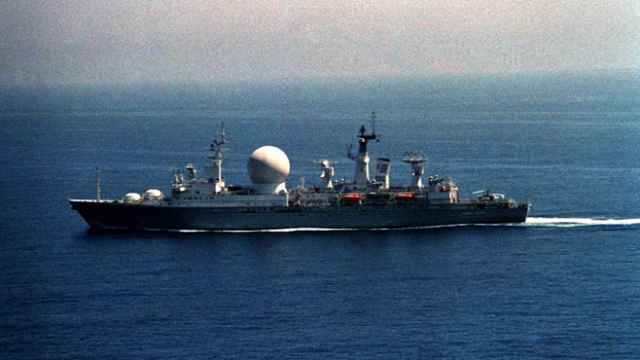The U.S. space agency NASA late last week tested a new Orion spacecraft intended eventually to take its astronauts to Mars, the latest in a series of moves that threaten to squeeze Russian companies out of the U.S. space industry.
NASA has not designed a new vehicle capable of transporting astronauts since the 1970s, when the space shuttles were built. Meanwhile, the U.S. space industry has grown reliant on Russian rocket manufacturers.
Orion on Thursday traveled far above the International Space Station to heights that no spacecraft designed for humans has reached since the Apollo moon missions 40 years ago.
The test flight — which lasted four and a half hours — saw Orion blast off from Florida at 7:05 local time, pass through the thick clouds of radiation circling the earth known as the Van Allen belt, orbit the planet and then return for a splashdown off the coast of San Diego in the Pacific Ocean.
The successful flight is a major step forward for NASA, which has struggled to overcome funding problems, lack of government support, and criticisms that it has become too dependent on the Russian federal space agency Roscosmos, which provided NASA with seats aboard Russia’s Soyuz craft for transporting astronauts into space.
Other U.S. dependencies include engine supplies from Russia’s NPO Energomash. The U.S. Air Force depends on the company's RD-180 engines to power its national security satellites into orbit.
While Orion is not the ship that will directly replace the Soyuz, it means U.S. astronauts are again traveling to space on home-grown engineering.
Boeing, the builder of Orion, is building another space capsule for NASA that will be used to transport astronauts to the space station. California-based space startup SpaceX is also building a space taxi for NASA. Both vehicles should fly by 2017.
Orion is a more ambitious vehicle than anything currently fielded by Russia. Designed for deep-space missions, the new U.S. space ship will eventually be launched aboard a massive new rocket that is still in development, known as the Space Launch System (SLS).
Russia also has a brand new rocket nearing completion — the Angara — with a test launch scheduled for Christmas day, but it is smaller than SLS and cannot lift as much into orbit.
However, Russia has yet to design a new manned space capsule to replace the 40-year-old Soyuz. Russia’s approach to manned spaceflight has focused on using proven designs and upgrading them as needed over the years.
Russia’s Energia space company, the prime contractor for all Russia’s manned spacecraft, presented proposals last year for a new spaceship to take cosmonauts to the moon and deep space that were similar to Orion, but so far no reports of concrete development work beyond the design phase have surfaced.
After a painful funding squeeze following the collapse of the Soviet Union, Russia is only now beginning to form coherent plans for deep-space and lunar exploration. There has been no need to develop a new Russian spaceship, as the Russian manned space program is entirely focused on the International Space Station, which is easily reached using the Soyuz space capsule.
Russia hopes to build a heavier rocket than Angara, which will allow it to reach the moon around 2030.
However, unlike NASA, which makes a point of hyping up its missions with significant press engagement and public relations multimedia, such as the flashy video explaining the significance and details of Orion’s test flight and the vehicle’s future applications, details of the Angara's Christmas test flight are not likely to be as forthcoming.
The last Angara launch was broadcast live on Russian state television, but was cancelled seconds before blastoff due to technical problems with a fuel valve. The second attempt a few weeks later was conducted in a media blackout.
Contact the author at bizreporter@imedia.ru
A Message from The Moscow Times:
Dear readers,
We are facing unprecedented challenges. Russia's Prosecutor General's Office has designated The Moscow Times as an "undesirable" organization, criminalizing our work and putting our staff at risk of prosecution. This follows our earlier unjust labeling as a "foreign agent."
These actions are direct attempts to silence independent journalism in Russia. The authorities claim our work "discredits the decisions of the Russian leadership." We see things differently: we strive to provide accurate, unbiased reporting on Russia.
We, the journalists of The Moscow Times, refuse to be silenced. But to continue our work, we need your help.
Your support, no matter how small, makes a world of difference. If you can, please support us monthly starting from just $2. It's quick to set up, and every contribution makes a significant impact.
By supporting The Moscow Times, you're defending open, independent journalism in the face of repression. Thank you for standing with us.
Remind me later.






